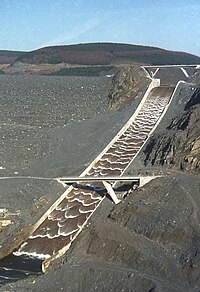Llyn Brianne: Difference between revisions
Llandeilopat (talk | contribs) adding external link to panoramic movies of the dam |
|||
| Line 66: | Line 66: | ||
*[http://www.carmarthenshire.org.uk/Llyn%20Brianne%20Reservoir/llyn_brianne_reservoir.htm Analysis of the dam] |
*[http://www.carmarthenshire.org.uk/Llyn%20Brianne%20Reservoir/llyn_brianne_reservoir.htm Analysis of the dam] |
||
*[http://www.cilycwm.com/lo_brianne.php Hydroelectricity scheme] |
*[http://www.cilycwm.com/lo_brianne.php Hydroelectricity scheme] |
||
*[http://www.llandeilo.net/panorama.php?label=Llyn+Brianne+Reservoir Panoramic movies of the dam] |
|||
[[Category:Geography of Carmarthenshire]] |
[[Category:Geography of Carmarthenshire]] |
||
Revision as of 22:39, 25 November 2010
| Llyn Brianne | |
|---|---|
| Location | Wales |
| Coordinates | 52°8′N 3°45′W / 52.133°N 3.750°W |
| Type | reservoir |
| Basin countries | United Kingdom |
Llyn Brianne is a man-made lake or reservoir in the headwaters of the River Tywi in central Wales.
Construction
The reservoir was constructed by Wimpey Construction in the late 1960s and early 1970s in order to regulate the flow in the River Tywi to support large potable water abstraction at Nantgaredig in the lower reaches of the river near Carmarthen, providing water to the Felindre water treatment works; the treated water is piped to a large area of South Wales up to the borders of Cardiff.
Under the reservoir there are a couple of houses, which were flooded to make way for the water reservoir. Before the water level was raised, it was possible to walk to Fannog farmhouse as a "For Sale" sign was once erected on it. It is still possible to see the top of the house when the water levels are low.
Structure
The dam is a crushed and larger rock clay filled dam, all materials being obtained in the area itself. In essence it is a constructed mountain blocking the valley. The clay was harvested higher up the valley near Soar y mynydd chapel closer to Tregaron. Much of the rock was harvested at the site. An on-site stone-crusher was used to reduce larger rocks to the various sizes required. A round-the-clock labouring system enabled its completion almost two years ahead of schedule.
Fish conservation
Because of the importance of the River Towy salmon and trout fisheries, special protective measures were incorporated into the construction of the reservoir including a smolt trap and a restocking programme using artificially raised parr. Releases of water from the dam tend to be very cold and are also blamed by anglers for a reduction in the quality of the fishery.
Hydroelectric scheme
The spillway of the dam is a notable tourist attraction when the reservoir is spilling. The dam is the UK's tallest, standing at a height of 300 ft (91 m), and is the world's largest clay core dam. In 1996 the reservoir spillway was increased by 1 metre in height and a hydro electric generating station was added at the base of the dam. When all three turbines are working, it generates 4.3 megawatts of electricity.
Kayaking

The spillway has recently been used by kayakers to slide down while the water is in flood. However this activity is banned by Welsh Water, and they issued a statement in 2008 calling the practice "dangerous" and stating that such activities were banned at the reservoir.[1]
See also
References
- ^ "Kayakers' 300ft dam drop attacked". BBC. 2008-11-18. Retrieved 2008-11-18.
Further reading
- Lillicrap, R. J. The Llyn Brianne Dam and the River Towy Scheme. Llandovery: Llandovery Publications, 1998.
